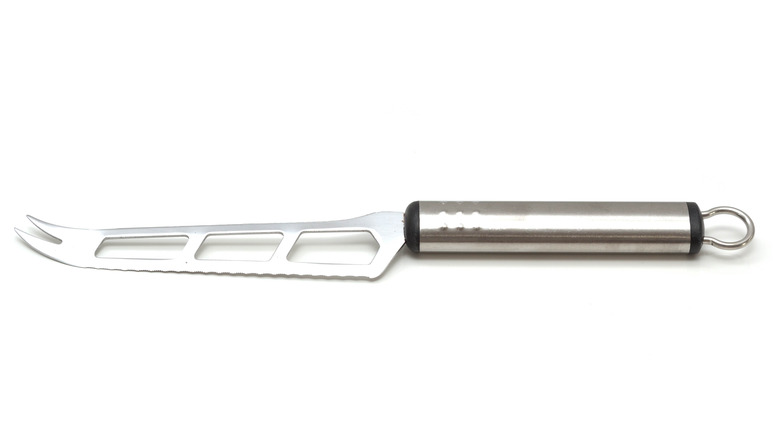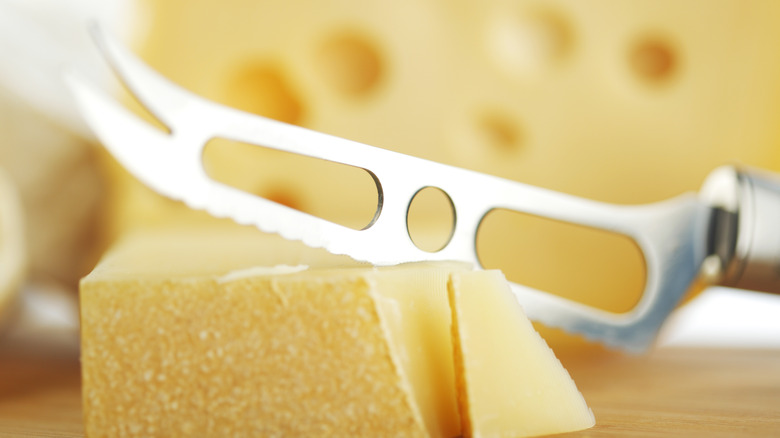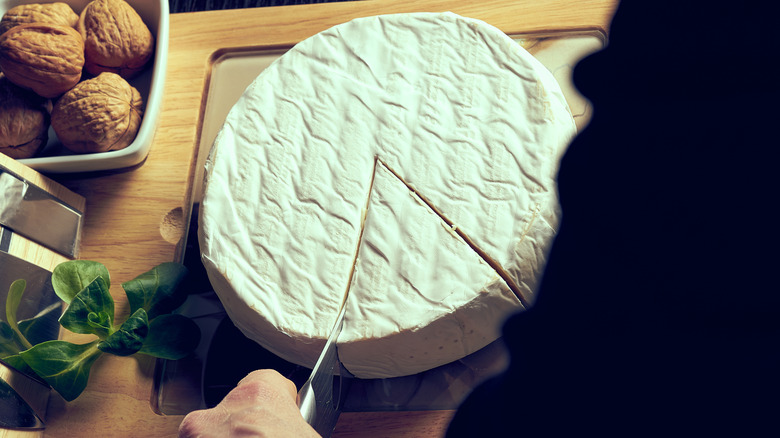What Makes A Skeleton Knife So Ideal For Cutting Cheese?
High-quality artisan cheese is already pricey, and getting all of the requisite gadgets and accouterments can rack up quite a bill and take up considerable kitchen space. Depending on the recipe, you might find yourself in need of a cheese grater, a fondue set, or a cheese wire (often used for cutting delicate blue cheeses, per Cheese Grotto) — or, at least, a sturdy cutting board and a decent knife. Fancy pairings, such as marcona almonds and fine charcuterie, will set you back further. And the wider variety of cheeses you take home, the more you'll need to invest in a veritable armory of specialized blades all dedicated to the surprisingly complex task of efficiently serving cheese.
The spatula-like planer is used to remove very thin shaved layers from harder, solid wedged cheeses. According to Culture, these delightful bites offer the true taste of the cheese via unparalleled air exposure. Culture adds that the cleaver or wedge, a short knife that can be pointy- or flat-ended, is for dismantling pebbly, aged cheeses. And the self-explanatory spreader is utilized for soft, smushy cheeses such as chèvre.
But there's a strange-looking tool in this cheesy arsenal, which Culture defines as a "skeleton knife." It's a long, narrow blade with holes in it. So, how is it used, and why do you need one?
What is a skeleton knife?
A skeleton knife (or soft-cheese knife) is a smallish knife, sometimes curved upward at the tip, with a series of holes along the blade's length. These apertures might be round or squared, matching the angle of the cutting edge, and the knife may be serrated or plain edge. Cookware & More explains that the former is best for soft foods with a harder exterior and the latter works when strong, even cuts are needed, as with firmer cheeses. At first glance, the bare-bones skeleton knife might seem strange and ineffective; after all, there's not much knife there. But that's the whole point.
Culture explains that skeleton knives' telltale holes keep cheese from getting stuck to the blade as you slice and plate it. This means you get neater cuts with less mess and waste — maximizing enjoyment of every morsel on your delicious cheese board. While the planer capitalizes on surface area for flavor, the skeleton knife reduces it so that every slice provides as much cheese as possible.
Cheese Grotto adds that soft cheeses with rinds can get squashed with other blades, so choose your weapon wisely. Reach for the skeleton knife for blues, bries, and other soft-ripened and washed-rind cheeses.
Using a skeleton knife for cheese
As detailed by Cheese Grotto, cheese deserves more than getting thoughtlessly hacked into bits. It's all about cutting it into the thinnest, broadest pieces as possible to ensure full fromage flavor. The outlet suggests using a skeleton knife to cut soft cheeses into slices one-eighth of an inch thick and break them down into narrower rectangles or even diagonal triangles. You can cut logs into rounds and turn small wheels into a series of pie slices for cheeses such as Camembert, or Mt. Tam.
Cheese Grotto also writes that a skeleton knife makes short work of pyramid-shaped cheeses and oozy, creamy specimens (such as Humboldt Fog).
However, Cheese Grotto adds that for hard, aged cheeses such as mature goudas and Parmigiano Reggiano, you're better off turning it into crumbly bite-sized chunks; that's out of the skeleton knife's wheelhouse. In the absence of a soft-cheese knife or wire, the outlet recommends using unwaxed dental floss (just make sure it's not minty or cinnamon-flavored so it won't taint your cheese board). Make no bones about it — a skeleton knife is a must-have for any cheese lover and a worthy addition to your cutlery collection.


